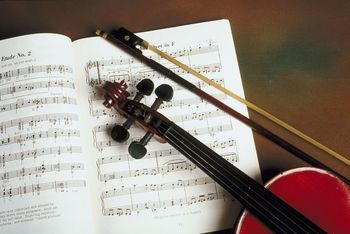How to Read Music
Reading music takes a minute to learn but a lifetime to master. Many people go to school for years to learn how to read music. Here’s a quick primer on reading music.
Learning to Read Sheet Music
Learning to read sheet music requires that you understand some basic definitions and terms which we will discuss in the next few paragraphs.
The Clef
Start out by identifying what is called the “clef”. The first symbol written on a staff (the five lines that make up a piece of music) is the clef, and it informs the music reader which lines and spaces on the staff correspond with which notes. This is the first step in music reading.
Key Signature
Next up, something called the “key signature”. Right next to the clef you found already is one or more symbols indicating “flat” or “sharp” notes. Musicians call this group of symbols the key signature. If there are no so such symbols, then the key signature is “natural” (neither sharp nor flat). It may take some time to be able to “read” a key signature, but it will become more important the more music you read.
Time Signature

How to Read Music
Now let’s move on to the time signature. To the right of the key signature, if any flat or sharp symbols are there to make up a key signature, is a strange looking number known as the time signature, or “meter signature”. It looks like two numbers on top of one another — think of it as a fraction. The top number in a key signature tells you how many individual “beats” are in a single measure (or “bar”) of music. As an example, if the time signature reads like this — 3 / 4 — there are three beats in each measure. See the three there? That’s how you know.
The bottom number in the time signature will tell you what “sort” of note equals one beat. This number can be a 4 (indicating a quarter note), a 2 (indicating a half note), or a 6 or an 8, each of which indicates that certain type of note gets the beat.
Reading Music
Now you’re ready for some rudimentary music reading — read the notes and rests (breaks in the music) as they relate to the time signature. All music pieces are read from left to right. The symbols on the music either represent notes to play or rests to take pauses during. Since rests mean you should be silent, they do not communicate a specific pitch for playing or singing — though they show up on the same place on the staff as a note.
Reading music gives a person a whole new world to exist in — almost everyone can read books, and many people can hum a tune, but few people have the ability to look at a piece of music and determine what that music sounds like. Scientists tell us that the ability to read music increases brain power, performance on tests, and could even play a role in sexual selection — all this adds up to one thing. You need to learn to read and play music. Reading music offers a person a lifetime of joy that not many experience, so pick up a score and trudge your way through as soon as possible. You’ll be reading complex operas and symphonies before you know it.
